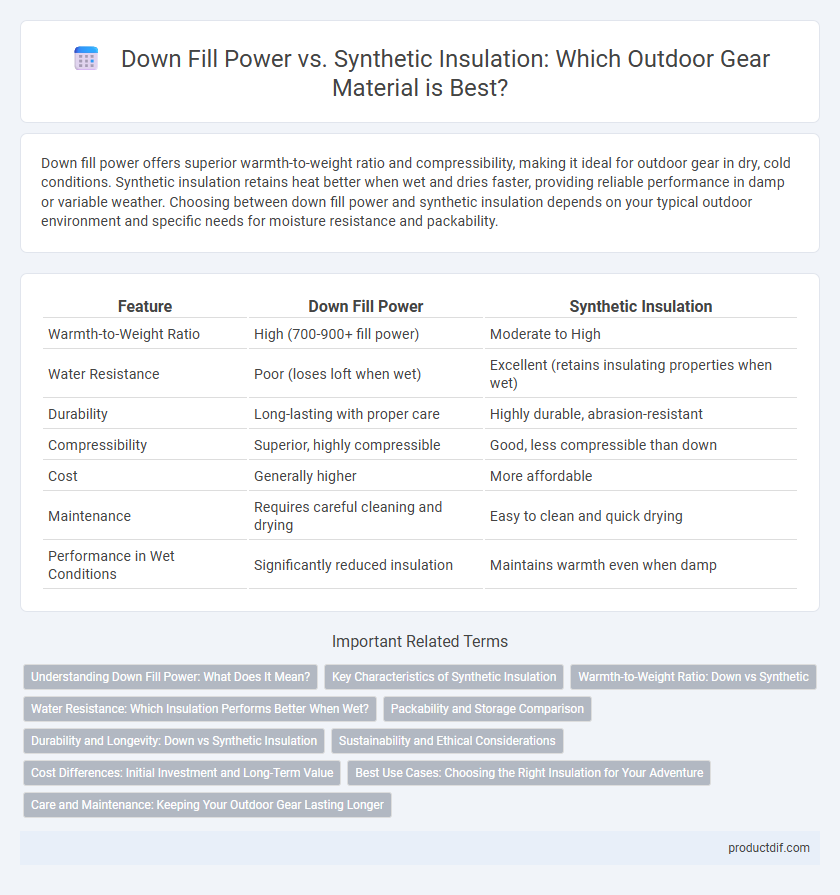Down fill power offers superior warmth-to-weight ratio and compressibility, making it ideal for outdoor gear in dry, cold conditions. Synthetic insulation retains heat better when wet and dries faster, providing reliable performance in damp or variable weather. Choosing between down fill power and synthetic insulation depends on your typical outdoor environment and specific needs for moisture resistance and packability.
Table of Comparison
| Feature | Down Fill Power | Synthetic Insulation |
|---|---|---|
| Warmth-to-Weight Ratio | High (700-900+ fill power) | Moderate to High |
| Water Resistance | Poor (loses loft when wet) | Excellent (retains insulating properties when wet) |
| Durability | Long-lasting with proper care | Highly durable, abrasion-resistant |
| Compressibility | Superior, highly compressible | Good, less compressible than down |
| Cost | Generally higher | More affordable |
| Maintenance | Requires careful cleaning and drying | Easy to clean and quick drying |
| Performance in Wet Conditions | Significantly reduced insulation | Maintains warmth even when damp |
Understanding Down Fill Power: What Does It Mean?
Down fill power measures the loft or fluffiness of down insulation, indicating its ability to trap air and retain heat, typically rated between 300 and 900 fill power. A higher fill power, such as 800 or above, signifies superior warmth-to-weight ratio, making it ideal for lightweight and highly compressible outdoor gear. Unlike synthetic insulation, down's fill power directly correlates with insulation efficiency and durability under cold, dry conditions.
Key Characteristics of Synthetic Insulation
Synthetic insulation features superior water resistance, maintaining warmth even when wet, unlike down fill power which loses loft and insulation efficiency when damp. It is typically heavier and less compressible but offers excellent durability and quick-drying properties, making it ideal for wet or humid outdoor conditions. Synthetic fibers also provide consistent insulation performance and hypoallergenic benefits, catering to users with sensitivities to natural down.
Warmth-to-Weight Ratio: Down vs Synthetic
Down insulation offers a superior warmth-to-weight ratio compared to synthetic insulation, making it ideal for lightweight outdoor gear where maximizing thermal efficiency is crucial. Goose and duck down fills, with fill powers ranging from 600 to 900+, trap more air and provide higher loft, resulting in exceptional warmth without added bulk. Synthetic insulation, such as PrimaLoft or Thinsulate, generally weighs more to achieve similar warmth levels but retains insulating properties better when wet, offering reliable performance in damp conditions.
Water Resistance: Which Insulation Performs Better When Wet?
Down insulation typically loses loft and warmth when wet due to its natural fibers clumping together, making its thermal efficiency significantly lower without treatment. Synthetic insulation, such as polyester fibers, maintains insulation properties and dries faster because its structure resists water absorption. For outdoor gear subjected to wet conditions, synthetic insulation performs better in retaining warmth and managing moisture compared to untreated down fill power.
Packability and Storage Comparison
Down fill power offers superior compressibility, allowing jackets and sleeping bags to pack down smaller for efficient storage in backpacks. Synthetic insulation retains loft and warmth even when damp, but typically requires more space due to bulkier fibers, affecting packability. For ultralight packing and compact storage, high fill power down is preferred, while synthetic materials provide easier maintenance and performance in wet conditions.
Durability and Longevity: Down vs Synthetic Insulation
Down insulation offers exceptional longevity when properly cared for, with the ability to retain loft and warmth for many years due to its natural resilience. Synthetic insulation tends to degrade faster under repeated compression and exposure to moisture, reducing its insulating effectiveness over time. High-quality down with a fill power above 700 demonstrates superior durability compared to most synthetic alternatives, especially in dry conditions.
Sustainability and Ethical Considerations
Down fill power, measured in cubic inches per ounce, offers superior warmth-to-weight ratio and longevity, but its sustainability depends on responsible sourcing certified by organizations like the Responsible Down Standard (RDS). Synthetic insulation, typically made from recycled polyester, provides cruelty-free alternatives with greater moisture resistance and ease of washing, contributing to lower environmental impact in manufacturing. Choosing between down and synthetic insulation involves balancing ethical considerations such as animal welfare, carbon footprint, and end-of-life recyclability in outdoor gear.
Cost Differences: Initial Investment and Long-Term Value
Down fill power offers superior warmth-to-weight ratio, often translating to higher initial costs compared to synthetic insulation, which is generally more affordable upfront. Synthetic insulation maintains insulating properties when wet and requires less care, providing long-term value despite lower thermal efficiency per weight. Cost differences influence purchasing decisions, with down favored for lightweight expeditions and synthetic preferred for budget-conscious consumers seeking durability and moisture resistance.
Best Use Cases: Choosing the Right Insulation for Your Adventure
Down fill power offers superior warmth-to-weight ratio, making it ideal for dry, cold conditions like winter camping and alpine mountaineering where lightweight insulation is crucial. Synthetic insulation excels in wet or humid environments such as rainforests or damp backpacking trips because it retains warmth even when wet and dries faster. Selecting between down and synthetic insulation ensures optimal comfort and performance tailored to specific weather conditions and activities.
Care and Maintenance: Keeping Your Outdoor Gear Lasting Longer
Down insulation requires careful washing in mild detergent and thorough drying to maintain loft and prevent clumping, extending its lifespan. Synthetic insulation is more forgiving, often machine washable and quick-drying, retaining warmth even when damp. Proper storage in a dry, breathable bag avoids compression damage, preserving the insulating properties and ensuring your outdoor gear lasts through many adventures.
Down Fill Power vs Synthetic Insulation Infographic

 productdif.com
productdif.com